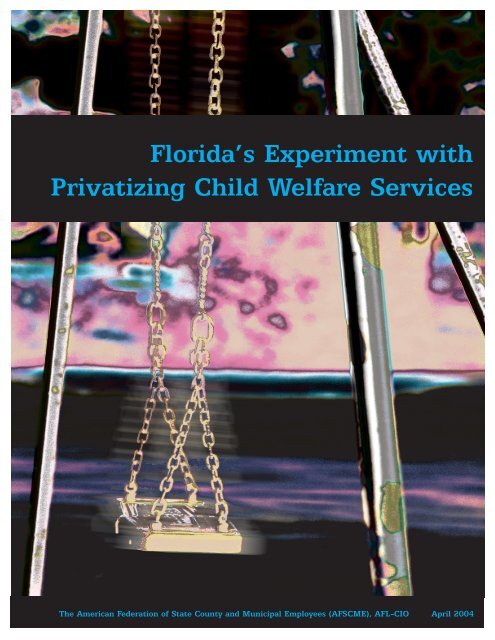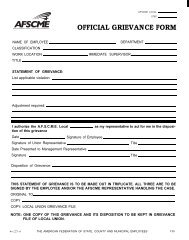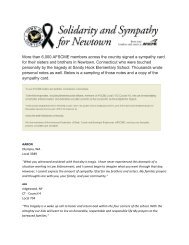Florida's Experiment with Privatizing Child Welfare Services - AFSCME
Florida's Experiment with Privatizing Child Welfare Services - AFSCME
Florida's Experiment with Privatizing Child Welfare Services - AFSCME
- No tags were found...
You also want an ePaper? Increase the reach of your titles
YUMPU automatically turns print PDFs into web optimized ePapers that Google loves.
Executive SummaryThe Florida State Department of <strong>Child</strong>ren and Families (DCF) spent $27.5 million onfive pilot programs set up to privatize child welfare services from 1997-2000. Even thoughfour of the five pilots failed, Florida is forging ahead <strong>with</strong> a statewide plan to privatize fostercare and all related services into Community-Based Care (CBC) programs.Of the five pilots, two were not successful and had their contracts terminated. Onepilot dropped out of the experiment. The for-profit virtually disappeared from public recordsand there is no further information on whether there were costs associated <strong>with</strong> it. SarasotaCounty is the only original pilot still in operation.Sarasota County’s success is unique. Experienced and active community stakeholdersand agencies were involved in the project from the beginning. Sarasota is one of thewealthiest counties in Florida, <strong>with</strong> residents who contribute substantial amounts of time andmoney to their community. This program spent 70 percent more on personnel than DCF inorder to reduce caseloads. In addition, the county has fewer children. As a result,comparisons to other programs are not accurate.Despite the fact that four out of the five original pilot projects were failing, the FloridaLegislature mandated in 1998 that foster care and all related services be privatized throughoutthe state between January 2000 and December 2002. This legislation required that DCFcontract <strong>with</strong> a single community-based provider in each area – a lead agency that administersservices. The state transfers all resources associated <strong>with</strong> child welfare to the agency and, inreturn, the agency assumes responsibility for serving all children <strong>with</strong>in the area who needcare. The lead agency is responsible for caseload and cost increases. Sarasota transitioned intoa lead agency.Government reports -- Progress Report: <strong>Child</strong> Protection Program Makes NeededChanges but Lacks Data for Evaluating Results of Initiatives and Special Report: DCF’s LeadAgency Readiness Assessment Process Meets Statutory Requirements but NeedsStrengthening -- show that even the state’s own researchers couldn’t find evidence showingthat privatization is better for the children of the state of Florida than a publicly-run childwelfare system.Florida recently released another Progress Report on programs for children andfamilies, including child welfare services. Some of the major accomplishments, includingincreasing the percentage of investigations completed <strong>with</strong>in 60 days and reductions ininvestigation backlogs, were tasks performed by public employees. The report highlights areduction in child welfare caseloads, but a Florida statue mandates caseload size.There is no evidence proving that privatization is better for Florida’s children than thepublic child welfare system it is replacing. The state’s own Office of Program Policy Analysisand Government Accountability’s reports acknowledged early on that several states, includingIllinois and Kansas, suffered problems after privatizing child welfare services.i
The problems in Florida’s experiment continue to escalate. A former lead agencyadministrator for Volusia and Flagler counties recently filed a whistleblower lawsuit againstthe lead agency, alleging in her wrongful discharge lawsuit that children were put indangerous situations and counselors did not get adequate training. In February 2004, the DCFput the Family Continuity Programs in Pinellas and Pasco Counties on a provisional licensefor overcrowding in foster care and lack of supervisory oversight..After eight years, millions of dollars and numerous studies, there is no evidence thatprivatized child welfare has made life any better for Florida’s most vulnerable citizens or fortaxpayers. The problem of ensuring the health, safety and well being of children in the childwelfare system is complex. And there is no evidence that Florida’s continuing rush towardprivatization will improve its child welfare system.
Introduction<strong>Child</strong> welfare systems across the nation are in crisis, <strong>with</strong> brutal workloads andinadequate resources to take care of the needs of abused and neglected children. Problems inFlorida’s child welfare system have received national attention. Scandals include thedisappearance of 5-year-old Rilya Wilson of Miami, the death of a 4-year-old found buried inNorth Fort Myers and the beating death of a 2-year-old boy in Central Florida. Last summer,the Florida Department of <strong>Child</strong>ren and Families (DCF) had a backlog of more than 30,000abuse and neglect investigations and, not surprisingly, high employee turnover.Florida began an experiment <strong>with</strong> the privatization of child welfare services in 1996<strong>with</strong> the passage of legislation mandating five pilot projects. Even though only one of theseprojects could be called successful, the state is forging ahead <strong>with</strong> statewide privatization,called Community Based Care (CBC). This is proceeding despite audits, evaluations andrecommendations that urged caution, and despite the fact that other states have experiencedsignificant problems <strong>with</strong> similar experiences. Florida made little effort to compare theprivatized system to the publicly operated one. Evaluations, required by the legislation, lackedmeaningful year-to-year or location-to-location comparisons.As of January 2004, approximately 42 percent of the children in Florida’s childwelfare system received services through privatized agencies. As of February 2004, theSuncoast Region; Districts 1, 2A, 9,10,14, and 15; and Duval County had service contracts<strong>with</strong> providers to operate CBC. St. Johns, Nassau, Seminole, Brevard, Clay/Baker andOrange/Osceola counties, and Districts 2B, 3, 11 and 13 have start-up contracts to transitionto CBC.Florida’s <strong>Child</strong> <strong>Welfare</strong> SystemDCF is responsible for all child welfare services, including child protection, fostercare, kinship foster care, independent living support, shelter care placement, adoption andfamily preservation. <strong>Services</strong> are delivered and data are collected by a combination ofcounties, regions and districts.Most social services are provided by districts. Florida currently has 13 districtscomprised of one to eight counties and one region, the Suncoast Region. The number ofdistricts, and the counties included, has changed over the years. Most state oversight andadministration is conducted at the district level and most of Florida’s social services data iscollected by district.In 2000, DCF recommended to the Legislature that it restructure itself from 15districts to seven regions. The Legislature approved one prototype region. DCF has indicatedthat it will form other regions, but will keep a limited district structure in place, since thedistricts are established in state statute (Regier, 2003, pp. 20-21).2
<strong>Child</strong> <strong>Welfare</strong> PrivatizationIn 1996, the Florida Legislature mandated that DCF establish pilot or model programsto privatize child welfare services in five districts, four specified in the law and one chosen byDCF, during fiscal year 1996-97.The pilot programs were in Escambia and Santa Rosa counties (District 1); Baker,Clay, Duval, Nassau and St. Johns counties (District 4); Lake and Sumter counties (District13); and Subdistrict 8A, Sarasota County. DCF chose Palm Beach County as the fifth pilot,which was to be operated by a for-profit corporation. The legislation stated that:By privatizing these services the support and commitment of communitiesto the reunification of families and care of children and their families willbe strengthened and efficiencies as well as increased accountability will begained (Florida Statutes 409.1671(1)).The legislation also called for DCF to establish a comprehensive system to measurethe outcomes and effectiveness of the services and to use this information in making futureprogram and funding decisions.Four out of the Five Pilots FailedDespite the fanfare and high hopes that greeted these pilot projects, most were adismal failure. One virtually disappeared, two other contracts were discontinued and anothernever got off the ground. Only one of the five pilots remains in operation.Pilot I, District 1: Escambia and Santa Rosa CountiesThis pilot was based on an existing program operated by <strong>Child</strong>ren’s Home Society(CHS)/Homeward Bound. The CHS/Homeward Bound project served two of the fourcounties in District 1: Escambia (Pensacola) and Santa Rosa. The project was run by the<strong>Child</strong>ren’s Home Society in Pensacola.The project was to serve children from birth to age 18 placed in substitute care for thefirst time, and children previously in CHS/Homeward Bound’s program returning to care dueto placement disruption.The contract ran from July 1997 to November 1999 at a total cost of $2,335,894. Theagency was not able to adapt to the CBC model and was no longer considered a pilot after1998 because it failed to increase placement resources. (Florida Legislature. Office ofProgram Policy Analysis and Government Accountability [OPPAGA], 2001, p. 44).Pilot II, District 4: Baker, Clay, Duval, Nassau and St. Johns CountiesFour residential agencies formed the Family <strong>Services</strong> Coalition to deliver services forchildren ages 12 to 17 in foster care and youth 18 and over in independent living. The Family<strong>Services</strong> Coalition served all five counties in District 4.3
The contract ran from January 1977 to June 2000 at a total cost of $9,565,060. DCFdiscontinued this contract in July 2000 because the agency did not meet outcome standardsand had high administrative costs. District staff reported that the coalition had limitedknowledge of foster care and needed assistance in casework, federal funding streams, judicialtimelines and other areas such as protective investigations and supervision (OPPAGA, 2001,p. 44).Pilot III, District 13: Lake and Sumter CountiesThe Bridges Program in District 13 was operated by the Lake County Boys Ranch andprovided services in Lake and Sumter counties from January 1997 to December 1999 at a costof $5,618,579.The agency had a 30-month contract <strong>with</strong> DCF funded at a case rate of $15,264 perchild. The Bridges Program had the most extensive managed care component of any of thepilots.The operation experienced a huge increase in caseloads, which placed a high level ofstress on the service delivery system and on the provider’s finances. By the third year of thecontract, caseload had quadrupled. From September 1998 to November 1998 DCFtransferred 300 of its cases to the Bridges Program. The high caseloads eventuallyoverwhelmed the capacity of the program to provide services.This increased caseload was well beyond projections and, as a result, the $15,264 caserate per child became unacceptable for the state. DCF amended the contract to reduce thepayments. This change placed the program at great financial risk so it requested more moneyfrom DCF. DCF was unable to provide additional funding so it did not renew the Bridgescontract.The Bridges Program had other problems. In November 1998, 6-year-old KaylaMcKean was killed by her father in Lake County. Kayla had been in the child welfare systemand under the care of the Bridges Program prior to her death. In April 2000, the Lake CountyBoys Ranch, which operated the Bridges Program, was indicted on charges of Medicaid fraudand grand theft based on evidence of over-billing, double billing and fraud (OPPAGA, 2001,p. 44).Pilot IV, District 8: Sarasota CountyThis program, operated by the Sarasota County Coalition for Families and <strong>Child</strong>ren,was implemented between January 1997 and June 1999 at a cost of $9,532,917. This is theonly original pilot project still in operation.The Sarasota County Coalition for Families and <strong>Child</strong>ren administers and coordinatesthe delivery of child welfare services for the entire Sarasota County population. The Youthand Family <strong>Services</strong> arm of the YMCA in Sarasota County provides administrative support tothe coalition. The project serves all children in Sarasota County needing protective services,foster care and adoption services (OPPAGA, 2001, p. 44).4
The success of this project probably was due to experienced and active communitystakeholders and agencies. Sarasota is one of the wealthiest counties in Florida, <strong>with</strong> acommunity that contributes substantial amounts of time and money to the project. The percapita income in Sarasota County in 1999 was $28,326 compared to $18,641 in EscambiaCounty and $15,164 in Baker County.The coalition spent 70 percent more on personnel than DCF in order to reducecaseloads. To do this, they used over $507,318 in donations. The coalition has indicated thatit will not be able to raise this amount of money on a regular basis. In addition, the coalitionran a deficit of $134,001, spread over seven agencies, for the first year (Peacock, 1998, p. 49).Sarasota County is demographically very different from the other pilot projects andfrom the rest of the state. In addition to a higher per capita income, Sarasota has fewerchildren. When questioned about these statistics in a review of the program, the stateresponded that Sarasota’s success was not tied to the relative wealth of the community andcould be duplicated throughout the state (OPPAGA, 2001, p. 77).Pilot V, Palm Beach County: For-Profit ProviderThe original legislation in 1996 directed DCF to include one pilot project operated bya for-profit provider. Palm Beach County was chosen, but there is no record of what happenedto the for-profit program in any evaluation. The requirement for it was subsequently removedfrom the legislation.All Pilots Had ProblemsAccording to OPPAGA, each pilot project had difficulties. Florida spent $27.5 millionon four projects from 1997 to 2000. Two were not successful and had their contractsterminated. One dropped out. The for-profit pilot never materialized. The pilots representedonly 1.9 percent of the state’s caseload. Only one pilot, Sarasota County, which differsmarkedly from the rest of the state in its demographics, remains in operation (OPPAGA,2001, pp. 41-49).Privatization Goes StatewideCommunity Based CareIn 1998, despite the fact that four out of the five original pilot projects were failing,the Florida Legislature mandated that foster care and all related services (including adoptiveservices, independent living, emergency shelter, residential group care, foster care, therapeuticfoster care, intensive residential treatment, case management, post placement supervision,permanent foster care and family reunification, shelter care and family preservation) beprivatized throughout the state between January 2000 and December 2002. This privatizationis called “community based care” (CBC). Initial investigations of abuse remain in public5
agencies or sheriff offices. Sheriff offices can contract out initial investigations of neglect butnot abuse.The legislation required that DCF contract <strong>with</strong> a community-based provider in eacharea -- a “lead agency” -- to administer services. The lead agencies subcontracted for services<strong>with</strong> community providers. DCF was required to transfer all available funds associated <strong>with</strong>the contracted services to the respective lead agencies. The legislation also added additionalcounties (Pinellas, Pasco and Manatee) in the pilot programs to replace the original pilots thatfailed.The legislation required lead agencies to coordinate and manage all child protectiveservices in the designated community, and to ensure continuity of care. They must alsoprovide or contract for all services needed and are accountable for meeting all state andfederal outcome standards. They must be willing to serve all children referred, regardless ofthe level of funding allocated by the state [Florida Statutes 409.1671(1) (c)].Risk-SharingThe contracts between lead agencies and the state of Florida are risk-sharingagreements. This means that the state transfers all resources associated <strong>with</strong> the child welfarefunction in return for the agency assuming responsibility for serving all children <strong>with</strong>in thearea who need care.In most privatization arrangements across the country, private agencies have beenfinanced through capitation or case rate payments that reflect the actual number of people theagency serves or is likely to serve. To the extent they “succeed,” it is often because they do nothave to assume the risk for factors beyond their control, as government agencies do. Florida isthe only state that gives a fixed amount of money to the lead agency and holds it responsible forproviding all services needed (Freundlich and Gerstenzang, 2003, p. 4).The lead agency is responsible for caseload and cost increases, even though they donot control the factors that influence the number of children in foster care. In a sense, thisputs them in a position similar to DCF.Brian Peacock, in the 1998 Interim Evaluation of the pilots, describes this situation:The Department’s burden is characterized by a limited amount ofmoney to serve a population that can grow, and has grown, <strong>with</strong>out limit.In effect, the Department is constantly at risk of having to serve childrenand families for whom no new resource allocations are made. This burdenoperationalizes <strong>with</strong>in the Department’s system of care in the form of highcaseloads, workers spread too thin, and too few resources to provideneeded services. Another characteristic of the Department’s burden is thatit cannot remove children/families from its caseloads who prove toochallenging to work <strong>with</strong>. Traditionally, the private sector’s relationship<strong>with</strong> the Department has included the potential for sendingchildren/families back to the Department due to the threat that problemcases posed to the well-being of the private programs.6
At the heart of the privatization demonstration effort is how the privatesector will address being given a finite amount of dollars to serve allchildren and families in need of help, <strong>with</strong>out the option of discontinuinginvolvement when cases become too challenging. Therefore, the extent towhich the individual privatization projects operate <strong>with</strong> the same levels ofrisk and uncertainty that the Department does is critical to being able toanswer how viable an alternative the private sector is to the Department(Peacock, 1998, p. iii).Peacock relates the process used to select a lead agency in Region 5 as an illustrationof the risk agencies must accept. Devereux, an agency <strong>with</strong> services in several statesthroughout the country, was recommended to DCF as a lead agency. Once informed that itwould be exposed to virtually unlimited risk, Devereux indicated that its board of directorshad no interest in becoming a lead agency.The failure of four out of the five pilot projects appears to confirm that the privateproviders, by their very nature and structure, cannot assume this risk.In even the best of circumstances governments do not meet all the needs of allcitizens. Choices must be made and governments make them all the time. There are incomeand asset level cutoffs for various types of economic assistance. Some programs, such assubsidized housing, are limited by the supply of units the government makes available. Thereare a limited number of slots in job training programs and at public universities. In ademocratic society, elected officials, directly accountable to the public, make these choicesthrough the legislative process. In the case of CBC, Florida is asking private agencies,accountable to their board of directors rather than to the general public, to make these toughchoices based on their growing caseloads yet limited resources. Cut backs will have to bemade but there will be no immediate public scrutiny of these decisions.Does Privatization Work?After many years, millions of dollars and several studies, the simple question of howFlorida’s privatized child welfare programs work compared to the public child welfare systemcannot be answered. The Legislature laid out specific objectives in authorizing thisexperiment – to strengthen the support and commitment of communities to the reunificationof families and care of children and their families and to gain efficiencies and increaseaccountability. Whether any of these objectives have been met is an open question.HomeSafenetHomeSafenet, the state’s automated child welfare information system, is part of theproblem when it comes to evaluating the outcome of Florida’s privatization of child welfareservices. In 1993, the federal government began providing funds for states to developautomated child welfare information systems, to ensure that states were capturing uniformdata for federal monitoring of state performance. Ten years and $230.2 million later,Florida’s system is still not completely operational.7
Florida received federal approval for its program in 1993-94. DCF contracted in1994-95 for planning and designing the system. However, the contractor experienced delaysand did not complete its work until one year later than planned.In 1996-97, the state began developing a request for proposals (RFP) for implementingthe new system. However, the RFP was delayed because of concerns from the federalgovernment and the governor’s office. The RFP eventually was issued but the state could notreach agreement <strong>with</strong> the vendors. As a result, DCF decided to implement the system inhouseduring 1999-2000 (OPPAGA, 2002, pp. 30-32).In November 2000, DCF began implementing HomeSafenet Release 1, which containsbasic case management, demographic and child placement information, in one district. Alldistricts were supposed to be phased into the system by October 2001. DCF began phasingout the use of its previous system in 2000-2001, before the new system was operational. DCFdid not anticipate having complete data in HomeSafenet for certain performance measuresuntil 2002. As a result, DCF cannot provide complete information on the status of children incare during fiscal year 2000-01. For example, DCF does not have data for this period on thenumber of children who were re-abused or the number of children who were returned to fostercare. Program officials previously reported to OPPAGA that complete performance data forFiscal Year 2001-02 would be available by August 2002 (OPPAGA, 2002, p. 32). However,this deadline was not met (OPPAGA January 2003, p. 9).The second release of HomeSafenet was scheduled to begin in early 2002 and wasintended to provide enhanced case management capabilities. A subsequent release, scheduledin August 2003, was supposed to include contract management, financial management,eligibility determinations, the Florida Abuse Hotline Information System and the adoptionexchange. When these releases are complete, all performance information will be availablefrom HomeSafenet.In October of 2002, however, DCF put implementation of these releases on hold.Current estimates are that HomeSafenet will not be fully operational until 2005 (Freundlichand Gerstenzang, 2003, p. 77). According to a recent OPPAGA report (February 2004),HomeSafenet “will not be completed before all lead agencies have taken over the provision ofchild welfare services.”Thus, an accurate assessment of Florida’s experiment <strong>with</strong> children is almostimpossible. HomeSafenet does not yet function properly after years of delays and millions ofdollars. Changes in reporting entities and reported data, whether districts, regions, counties,sub-counties or zones, make it difficult to compare data to interpret results.Although governments must adopt better measures of performance when they becomeavailable, it is reasonable to continue using both old and new measures for a period of time.This allows a check on the new measure and comparisons over time. Florida did not.EvaluationsBeyond problems <strong>with</strong> HomeSafenet, the state also has not compared results beforeand after implementing CBC. The absence of this “baseline data” makes it very difficult to8
determine if privatization has succeeded. In fact, it seems the first time that baseline data wasgathered was in the University of South Florida Evaluation for 2002-03 (see page 10). Itstated that data for start-up counties was included that year “in order to gather some baselinedata for future comparisons” (Paulson, et al., 2003). This is six years after the program began!Further, Florida has not required consistent data in the various studies and evaluationsof the pilots. Each evaluation has use different criteria and comparison counties.The state of Florida has commissioned numerous evaluations of this experiment overthe years. These evaluations provide no evidence that the privatized programs work anybetter than the public system they replaced, despite all the public and private money that hasbeen spent on them. There is also no evidence that they work any better than the publiclyoperated systems currently in place in many Florida counties.Interim EvaluationThe Interim Evaluation of the original pilot projects was released in March 1998. Thisevaluation compared CBC counties to other counties in their regions that were not in CBC. Itstated that much more study was needed before CBC could be implemented on a broaderscale, especially in rural areas that lacked sufficient services:It is therefore necessary that there not be a haste to dismantle DCF’s childwelfare function” (Peacock, 1998, Section 4, p. xix).The report recommended that the pilots be given sufficient time to demonstrate theirstrengths and shortcomings before broad implementation of child welfare privatization.The Interim Evaluation further stated:After the Sarasota County Coalition, the Bridges Program should mostcompletely answer the question of how the private sector manages theburden of assuming the role and function of the Department. The BridgesProgram has to accept all children coming into care through the sheltersystem for the first time in Lake and Sumter Counties. The BridgesProgram receives a fixed amount per child and that amount does notincrease regardless of how long the child is in care; i.e., there is risk to theBridges Program for the children it serves. Furthermore, in recentdiscussions between the Department and the Bridges Program about abudget deficit in District 13, the Bridges Program has acknowledged that itwill not deny services to children who enter the program and for whom thecase rate is not available because of the budget deficit. The program hasclearly put itself in the shoes of the Department in taking this position.Lastly, the Bridges Program cannot send children back to the Departmentwhen a case becomes too challenging. Over time, the Bridges Programshould provide a variety of useful answers regarding private sectorcapability to manage the role and function of the Department. This maybe especially true as it relates to smaller, more rural districts (Peacock,1998, Section 4, p. xvi).9
The fact that the Bridges Program was discontinued would seem to answer thequestion of private sector capability to assume DCF’s role and functions.Although the Interim Evaluation indicated that staff and clients liked the privatesystem better, the author notes that this may be because the private agencies are notresponsible for protective services, which have traditionally been somewhat adversarial. Inaddition, non privatized sites have caseloads approximately 69 percent higher than privatizedsites and, as a result, privatized sites seem to respond more quickly, which could also affectstaff and client satisfaction. The report further states that a long demonstration period isneeded to see if outcomes are actually related to privatization.Outcome EvaluationThe 1998-99 Outcome Evaluation of the original pilots, also prepared by Peacock,contains no comparisons on performance measures. In this report the author cautions DCFthat measurable outcomes, tracked over a sufficient period, are necessary to determine ifprivatized child welfare services are a better model than public services.He specifically states that DCF should ensure that current and future data systemssupport long-term outcome measurement. One of the report’s conclusions:There are simply too many issues regarding the accuracy of outcome datafrom Department data systems to be able to draw reliable conclusionsabout system performance on outcome measures that have been identifiedfor the community-based child welfare systems (Peacock, 1999, p. 5).Florida Office of Program Policy Analysis and Government Accountability (OPPAGA)March 2001OPPAGA conducts reviews of programs and identifies alternatives for improvingservices and reducing costs. In this report, OPPAGA concluded that each pilot project haddifficulties. It was difficult to establish lead agencies, primarily due to the unwillingness ofagencies to assume financial and legal risk. It noted that privatization will not be completedby 2003 as mandated by the legislature. The study drew no conclusions about theeffectiveness of the programs.It reported that DCF spent $27.5 million on the four pilot projects from 1997 to 2000.Two of the four pilots were not successful and had their contracts terminated. One droppedout. One was never mentioned after the original legislation. Only one, Sarasota, which metonly one of the outcome standards, transitioned to a lead agency.The audits prepared by OPPAGA do not include comparisons <strong>with</strong> other, non-pilotcounties.10
Markowitz EvaluationA study by Teresa Markowitz in 1999-2000 examined implementation of the pilotsand service delivery. It offered no evidence that the privatized system had better outcomesthan the previous system because DCF was unable to provide outcome data by site(Markowitz, 2000, p. 15).The Markowitz Evaluation of 2000 did not include comparisons <strong>with</strong> other nonprivatizedcounties.University of South Florida Evaluation 2001-02A study conducted by the University of South Florida in 2001-02 compared CBCcounties to similar counties in which CBC had not been implemented, CBC programs tosimilar programs and to the rest of the state and also looked at expenditure and demographicdata. It concluded there is “…insufficient evidence to conclude if the CBC model is more orless effective than the previous model” (Armstrong, et al., 2003, p. 4).This study also cautions that the results in CBC counties may not be transferable.These counties were committed to the reforms, had an agency interested in becoming a leadagency, were of reasonable size and had a sufficient resource base.University of South Florida Evaluation 2002-03This study, submitted to DCF in June 2003, only compares CBC counties <strong>with</strong> the restof the state. It indicated that it was too soon to determine if CBC had failed or succeeded(Paulson, et al., 2003, p. 1). This is six years after the pilot project legislation was enacted,four years after the Legislature decided to implement the experiment statewide and almosttwo years after Governor Jeb Bush stated that “Florida is leading the nation in the quietrevolution of child welfare reform" (Governor Bush’s address to DCIP summit in Orlando,Aug. 28, 2001).The USF Evaluation concluded that CBC counties performed at least as well as non-CBC counties. However, using a weighted average of counties that started CBC prior to thebeginning of the evaluation period and publicly administered counties, public agenciesoutperform the CBC. For example, 40 percent of the children in CBC left long-term fostercare <strong>with</strong>in 12 months, compared to 44 percent for the rest of the state. Using these sameweighted averages, only 44 percent of children in CBC counties were reunited <strong>with</strong> theirparents compared to 50.4 percent for the rest of the state.The 2002-03 study used different comparisons than were used the year before andalso used different populations and measures in different sections of the report. The“Outcome” section used all counties that had begun the start-up phase of CBC before the endof the evaluation period. The “Qualitative Analysis” chose two additional CBC operations.The “Financial” section used all counties that have begun CBC but prorated them for countiesthat had less than a full year’s experience.11
The qualitative analysis was intended to address whether the CBC model meets theneeds of the system’s users. Various users and providers were interviewed, each <strong>with</strong> a highstake in the success of CBC <strong>with</strong>in their communities. No state or CBC employees wereinterviewed. Only two sites, Hillsborough County and District 1 (Santa Rosa and EscambiaCounties) were surveyed. This analysis found that people liked the new system better thanthe old one. There were no comparisons to non-CBC counties (Paulson et al., 2003, pp. 32-43).University of Florida 2004 Legislative Report: Evaluation of Community-Based CareThis study purports to examine the expenditures for CBC and non-CBC sites andwhether the CBC was more effective than the state-run system. The report includes a seriesof tables comparing the CBC counties <strong>with</strong> the rest of the state based on six indicatorsincluding: the percentage of children entering out-of-home care and exiting <strong>with</strong>in 12 months;percentage of children experiencing recurrence of maltreatment <strong>with</strong>in 12 months after theirfirst episode; children returned to parents after exiting out-of-home care; and children placed<strong>with</strong> relatives after exiting out-of-home care.After making these comparisons, the report cautions that some of the CBC countiesare not fully operational because they are still in the process of implementing CBC. Thereport cautions that “no definite conclusions can be made about the effectiveness of CBCcounties regarding programmatic outcomes” and that the data sources are not completebecause HomeSafenet data has missing, incomplete and inaccurate records. (Paulson, et al, p.60)The report concludes that Sarasota and Manatee counties “appear to have achievedfavorable outcomes.” However, an examination of the tables shows that the state-run systemperformed better than Sarasota County in two categories, and better than Manatee County intwo other categories. Both counties performed better than the state-run system in just twocategories. (Paulson, et al, pp. 54 – 59)The same problems arise <strong>with</strong> the cost analysis data. The report states that CBC siteshad a slightly lower average expenditure per child than the non-CBC sites and a slightlyhigher average expenditure per child day than non-CBC sites. But the report cautions that thetransition from the CIS to HomeSafenet makes the data incomplete and unreliable andconcludes by stating “…the differences in average expenditures per child reported here shouldbe used for descriptive purposes only. It cannot be inferred from these findings that CBCsites has lower average expenditures per children than non-CBC sites because of the advent ofCBC.” (Paulson, et al, p. 69)Nevertheless, the report recommends that the state stay the course and continue toimplement CBC.Problems in Other StatesLike Florida, many states are changing the management, financing and delivery ofchild welfare services. In 2001, OPPAGA reported on problems other states had encounteredwhen privatizing child welfare services.12
IllinoisIllinois uses performance contracts. These contracts link reimbursement rates, orpayment schedules, to achieving specified performance indicators or client outcomes. TheIllinois Department of <strong>Child</strong>ren and Family <strong>Services</strong> (DCFS) has encountered somedifficulties. Most significantly, the contracting timeline does not allow DCFS to reviewresults from current contracts until after new contracts are signed.Another challenge is that the funding of performance contracting is dependent on thefailure of some agencies. Non-performing agencies are required to give up part of theircaseloads and their contract funds are subsequently reduced. This allows for the transfer of thecases and money to better performing agencies.KansasIn 1996, the Kansas Department of Social and Rehabilitative <strong>Services</strong> (SRS)privatized the majority of its child welfare services utilizing a “lead agency” approach similarto Florida’s.The original foster care contracts reimbursed providers <strong>with</strong> case rates at a capitatedlevel for each family or child. The first-year case rates were expected to cover all the costs ofproviding services. From 1997 to December 1998, however, SRS had to increase itspayments to providers by an additional $45.2 million for cost overruns and increases in thecase rate.In fiscal year 1999, SRS spent $111.9 million dollars on foster care services, a 50percent increase over the $74.7 million in fiscal year 1998. The number of clients in theprogram only increased 11 percent during the same time period. Staff turnover ranged from29 to 54 percent, so many staff were very inexperienced. Providers also reported that fundingshortages altered service provision. The providers were not able to pay subcontractors andfoster homes (OPPAGA, 2001, pp. 55-57).Difficulties PersistDespite a lack of evidence that CBC is working, Florida continues to charge ahead.The state continues to ignore concerns and makes changes only after major problems occur.Problems in Volusia and Flagler Counties (District 12)The experience of Volusia and Flagler Counties in implementing CBC illustrates someof the problems that can occur.In Volusia County, which implemented CBC in April 2002, the new systemexperienced many of the same problems encountered by the system it replaced. Anunexpected caseload increase of about 200 children in June and July of 2002 strained bothstaff and budgets, and resulted in the lead agency projecting a deficit of at least $500,000dollars by the end of the year. The funding, the second lowest in the state, was to stay at the13
same level for all five years of the contract. The parent of the lead agency had to step in andpay the salaries of new case managers hired to deal <strong>with</strong> the increased caseload (Wright,2002).In August 2003, the lead agency reported that it would be short at least $700,000 forthe 2003-04 fiscal year (Circelli, 2003). According to the Tallahassee Democrat “the agencymanaging foster care had staff turnover rates of more than 60 percent, had placed children inhomes <strong>with</strong> expired licenses and was consistently late <strong>with</strong> records needed for court hearings”(Bridges, 2003). Recently state reviewers criticized the agency “for failing to make requiredmonthly visits to foster children, high caseloads and accounting problems” (Krueger, January2004).Finally, in April a former lead agency administrator for Volusia and Flagler countiesfiled a whistleblower lawsuit against the lead agency, Community Based Care, for wrongfuldischarge. The suit alleges that the lead agency’s policies and practices put children indangerous situations and the agency did not train its counselors to provide meaningful casemanagement.Problems in Pinellas and Pasco Counties (District 5)Pinellas and Pasco were two counties that replaced the original failed counties as pilotprojects. Manatee was another. The 2002-03 USF Evaluation states that all four pilots(Sarasota, Manatee, Pinellas and Pasco) were successful in making the transition to a leadagency. However, the lead agency in Pinellas and Pasco, the Family Continuity Programs, hasbeen criticized in state reviews.In February 2004, Family Continuity Programs announced that it planned to lay off 30caseworkers. The DCF recently put the agency on a provisional license, criticizing it forallowing too many foster homes to become overcrowded and for a lack of supervisoryoversight (Krueger, February 2004).Legislative Changes and DelaysIn 2001, the law was amended to address areas where a lead agency could not befound. In 2002, the timeframe for implementation was again lengthened and the compositionof the pilot projects was changed. In 2003, the legislation was further amended to exemptfrom CBC counties that have 40 licensed group care beds and provide $2 million annually tosupplement foster care services. Language was also added to make sure certain localitieswere ready to implement CBC before the transfer took place. Finally, the 2004 deadline forfull statewide conversion was eliminated.ConclusionAfter eight years, millions of dollars and numerous studies, there is no evidence thatprivatized child welfare has made life any better for Florida’s most vulnerable citizens or fortaxpayers. There is no evidence that the privatized services are better than what they replaced,and some data suggest that counties in which child welfare is still operated by publicemployees did better than those that have been privatized. A study conducted by the14
University of South Florida in 2002 concluded there is “insufficient evidence to concludewhether the CBC model is more effective (or less effective) than the previous model.”Although there were cost variations between counties, none of the evaluations offered anyevidence that CBC is any more cost effective than the public system.Despite the legislative requirement for comprehensive measurement of theeffectiveness of privatized services, Florida began this experiment <strong>with</strong>out a system in placeto monitor results. Today, the state still cannot accurately evaluate if privatization worksbetter than the public system. It does not appear that they will have this capability any time inthe near future.Still, Florida continues its rush toward privatization.Those who devote their work lives to child welfare services know the system is indesperate need of change. They see first hand the tragic results when the system isdysfunctional and underfunded. They fully agree <strong>with</strong> the goal, expressed by the FloridaLegislature, to assure that children are safe and well nurtured, that families are strengthenedand reunified, and the program is accountable to taxpayers.They know this goal can only be met through better coordination among agencies,more attention to community needs, additional resources and better use of those resources.When New Jersey officials looked at their system after a nationally publicized case of neglect,the state realized it needed an additional 1,500 new staff to bring the workload to amanageable level to ensure the safety of the children of New Jersey. Transferring problemsfrom a public agency to a private agency does not ensure these problems will be solved northat children’s needs will be met. There are other ways to make improvements in adysfunctional system than turning to privatization.The problem of ensuring the health, safety and well being of children in the childwelfare system is complex. There is no evidence to support that Florida’s rush towardprivatization will improve its child welfare system.15
BibliographyArmstrong, M., Brown, E. Jordan, N., Kershaw, M. A., Paulson, R. I., Vargo, A. C., et al.Highlights: 2001-2002 Statewide Evaluation of Community-Based Care. Tampa: Universityof South Florida, Louis de la Parte Florida Mental Health Institute. Retrieved March 2, 2004from: http://www.dcf.state.fl.us/publications/docs/highlights_CBC_report_2002.pdfBridges, T. (March 9, 2003). Communities may hold the answer. Tallahassee Democrat, p.1A.Circelli, D. (August 19, 2003). Foster-care agency needs cash. Daytona Beach News-Journal, p. 1C.Fairbanks, D.L. (2002). Community-Based Care. Tallahassee: Florida Department of<strong>Child</strong>ren and Families. Retrieved on March 2, 2004 from:http://www.dcf.state.fl.us/cbc/docs/cbcsnapshot.pdfFlorida Legislature. Office of Program Policy Analysis and Government Accountability(2002). Progress Report of Justification Review: <strong>Child</strong> Protection Program, Department of<strong>Child</strong>ren and Families (No. 02-16). Tallahassee. Retrieved March 2, 2004 from:http://www.oppaga.state.fl.us/reports/pdf/0216rpt.pdfFlorida Legislature. Office of Program Policy Analysis and Government Accountability(2001). Justification Review: <strong>Child</strong> Protection Program, Department of <strong>Child</strong>ren andFamilies (No. 01-14). Tallahassee. Retrieved March 2, 2004 from:http://www.oppaga.state.fl.us/reports/pdf/0114rpt.pdfFlorida Legislature. Office of Program Policy Analysis and Government Accountability(2003) Progress Report: <strong>Child</strong> Protection Program Makes Needed Changes but Lacks Datafor Evaluating Results of Initiatives (No. 03-09). Tallahassee. Retrieved March 25, 2004from http://www.oppaga.state.fl.us/reports/pdf/0309rpt.pdfFlorida Legislature. Office of Program Policy Analysis and Government Accountability(2004) Special Report: DCF’s Lead Agency Readiness Assessment Process Meets StatutoryRequirements, but Needs Strengthening (No. 04-15). Tallahassee. Retrieved March 25, 2004from http://www.oppaga.state.fl.us/reports/pdf/0415rpt.pdfFreundlich, M. and Gerstenzang, S. (2003). An Assessment of the Privatization of <strong>Child</strong><strong>Welfare</strong> <strong>Services</strong>: Challenges and Success. Washington, D. C.: <strong>Child</strong> <strong>Welfare</strong> League ofAmerica.Krueger, C. (February 13, 2004). Foster care agency to cut staff. St. Petersburg Times, p. 1B.Krueger, C. (January 25, 2004). Initial stumble or permanent bungle? St. Petersburg Times,p.1BMarkowitz, T. (2000). Florida Community Based Care Evaluation 1999-2000. Tallahassee:Department of <strong>Child</strong>ren and Families. Retrieved March 2, 2004 from:16
http://www.dcf.state.fl.us/publications/docs/CBCeval.pdfPaulson, R.I., Armstrong, M., Brown, E., Jordan, N., Kershaw, M. A., Vargo, A., et al.(2002). Evaluation of the Florida Department of <strong>Child</strong>ren and Families Community-basedCare Initiative in Manatee, Sarasota, Pinellas and Pasco Counties: Final Report on FiscalYear 2001-2002. Tampa: University of South Florida, Louis de la Parte Florida MentalHealth Institute. Retrieved March 2, 2004 from:http://www.fmhi.usf.edu/institute/pubs/pdf/cfs/consortium/cbc_report_081602.pdfPaulson, R.I., Armstrong, M., Fitzpatrick, J., Jordan, N., Kershaw, M. A., Reyes, F., et al.(2003). Evaluation of the Florida Department of <strong>Child</strong>ren and Families Community-basedCare Initiative. Tampa: University of South Florida, Louis de la Parte Florida Mental HealthInstitute. Retrieved March 2, 2004 from:http://www.dcf.state.fl.us/publications/docs/cbc_report_091503.pdfPaulson, R.I., Armstrong, M., Jordan, N., Kershaw, M. A., Vargo, A., et al. (2004). 2004Legislative Report: Evaluation of Community-Based Care. Tampa: University of SouthFlorida. Retrieved March 2, 2004 from:http://www.dcf.state.fl.us/publications/docs/cbc_report_012204_final.pdfPeacock, B. (1998). Interim Evaluation of Florida’s <strong>Child</strong> <strong>Welfare</strong> Privatization Projects.Tallahassee: Florida Department of <strong>Child</strong>ren and Families. Retrieved March 2, 2004 from:http://www.dcf.state.fl.us/publications/docs/chldwel1.docPeacock, B. (1999). Final 1998-1999 Outcome Evaluation Report on Florida’s ContinuingCommunity-based <strong>Child</strong> <strong>Welfare</strong> Programs. Tallahassee: Florida Department of <strong>Child</strong>renand Families. Retrieved March 2, 2004 from:http://www.dcf.state.fl.us/publications/docs/bpreport/1covtoc.pdfRegier, Jerry, Secretary, Florida Department of <strong>Child</strong>ren and Families, Reforming the Social<strong>Services</strong> Partnership, Feb. 4, 2003.Senate Staff Analysis and Economic Impact Statement for CS/SB 1454. Tallahassee: FloridaSenate. Retrieved March 2, 2004 from:http://www.flsenate.gov/data/session/2003/Senate/bills/analysis/pdf/2003s1454.ap.pdfWright, S. (December 15, 2002). Local foster care agency reaches crisis point. Daytona BeachNews-Journal, p.17A.17
















